Becoming a guitar master is no easy feat…
It takes time, consistency, and dedication to improve your skill set week after week, no matter how many years you’ve been playing. Guitarists who stop learning run the risk of stagnating their progress, forever stuck playing the same 3 chords to the same boring pop songs.
That’s why we’ve come up with a list of 7 guitar picking techniques you can use to master your instrument and improve your sound. Ranging from beginner-friendly to advanced, these techniques will elevate your playing and keep you sounding fresh, dynamic, and bold, as you continue your journey of guitar mastery.
Table of Contents
To Pick or Not to Pick?
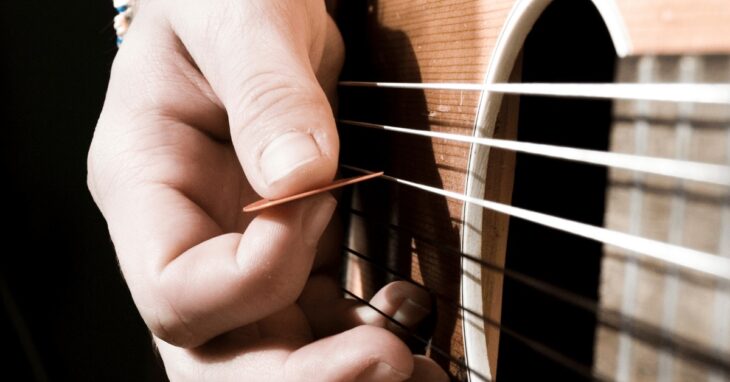
Using a pick is both a personal and practical choice guitarists make when they set out to play. Playing styles like classical or flamenco guitar require the player to use their fingers to achieve complicated sounds and strokes.
Meanwhile, steel string guitarists love to use picks because of the added utility a pick gives them. It makes strumming easier, makes their strings sound louder, and there are a bunch of techniques that can only be achieved by using a pick.
Pick Thickness
The pick thickness can have an impact on your playability and style. Picks can be separated into three categories, “thin”, “medium” and “heavy”. There’s no right or wrong thickness to use and it’s all about personal preference. Just keep in mind, different thicknesses give slight tonal differences so it’s worth experimenting with size to see which one suits you and your playstyle best.
How to Hold the Pick
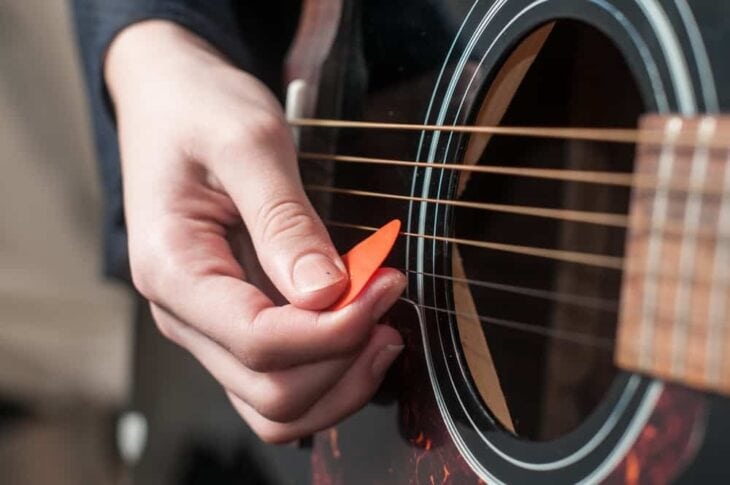
Before we get started, it’s worth making sure you know the correct way to hold a pick. Start by gripping the pick with your thumb and the outer edge of your index finger, almost like you’re doing an “OK” signal with your fingers. Close the other fingers into your palm to keep them out of the way and you’re ready to go!
Alternate Picking

One of the first picking techniques you’ll want to master is alternate picking. Not only will it improve your sound, but it also helps to lay the foundations for so many other picking techniques on this list.
How It’s Done
When beginners pluck their strings, they usually do so with that familiar, down down down motion, that feels the most natural. But this technique is limiting and any guitarist who wants to graduate to playing harder riffs or solos needs a better way to pluck their strings. That’s where alternate picking comes in.
Instead of just picking on the down stroke, alternate picking is where you alternate between picking up and down on the string. This technique helps to make your playing faster, more efficient and gives it a unique sound.
It’s All About the Angles…
The trick to nailing this technique is in the way you hold your pick. Instead of holding it flat against the string like you would downpicking, try holding the pick at an angle and using the edges to hit the string instead. This should give you better control and movement over the string allowing you to be as fast as you want.
Tremolo Picking
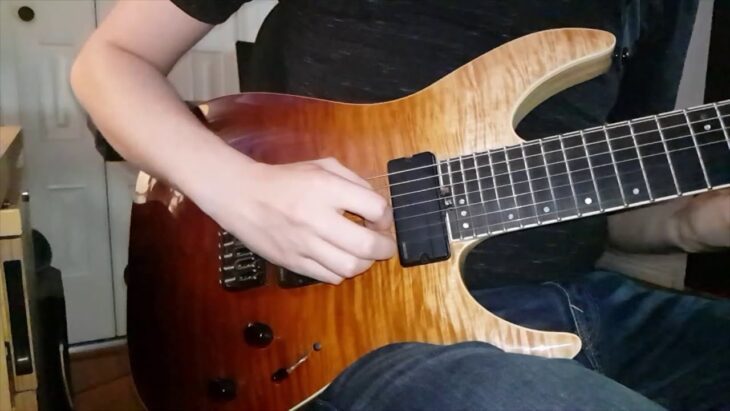
This technique gets its name from the Italian word tremolo, “to shake” or “tremble”, and has nothing to do with the tremolo system by your bridge. It’s a pretty simple technique to learn and one that’s been instrumental in defining the sound of surf rock, classical rock, and even metal. To get this one sounding right, you’re only gonna need one thing… speed.
How It’s Done
Tremolo picking involves striking one string, repeatedly, as fast as you can in an alternate picking pattern to create a “chugging” sound. If you want a textbook example of tremolo picking in action, check out Dick Dale’s left hand in this Guitar Center Sessions video as he plays probably the most recognizable song to use tremolo picking.
If You’re Struggling
Firstly, make sure you have an anchor point for your hand, to help keep it steady and lined up. A lot of guitarists like to rest their palm on the top of the bridge to help them stay accurate.
You also want to make sure you’re using a combination of your wrist and fingers to achieve the repetitive striking motion. Using just your wrist will make it harder to be accurate while only using your fingers won’t generate enough speed to make the technique sound good.
Finally, you want to be using only the tip of your pick to hit the strings as the more contact your pick has with the strings the more they’ll be slowed down.
Crosspicking
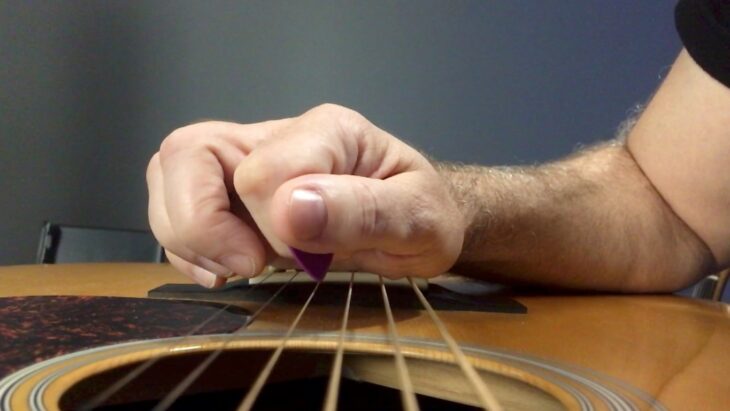
If you’re looking to get that iconic country bluegrass sound, you need to get comfortable crosspicking and crosspicking well. This technique is more of an intermediate picking style as it requires the player to be comfortable picking on multiple strings, fast, and in rhythm.
How It’s Done
To crosspick, you need to take a flat pick and play a rolling pattern across three adjacent strings. The sound is meant to resemble a banjo roll so you’ll want to try and imitate that “waterfall” effect with the three strings. It doesn’t necessarily matter which three strings you use but to get that authentic crosspicking sound you want to play a descending sweep from your root note.
So Much Variety
This is only the tip of the iceberg. What we just broke down for you is the most basic crosspicking pattern there is. Once you’ve mastered this basic pattern, there’s a whole world of crosspicking patterns that have been used by just about everyone in popular music, including Dylan on The Times They Are A-Changin’ and Buckingham on Landslides. Slight variations to this picking pattern can help elevate your song to the next level.
Hybrid Picking
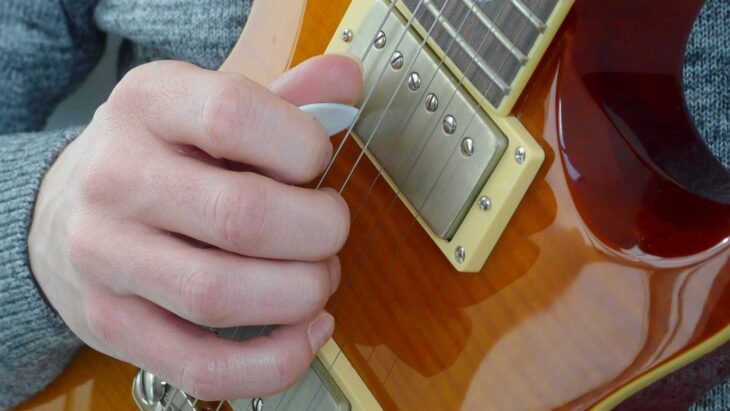
If you’re looking for a picking technique that will let you play two or more strings at once you need to familiarize yourself with hybrid picking. This technique can be a bit fiddly for beginners as it requires you to use both your pick and your fingers at the same time to pull different strings in unison but I promise, with just a bit of practice, you can add a unique and solid technique to your toolbox.
How It’s Done
The difficulty comes more in hand dexterity as hybrid picking is actually pretty straightforward. To hybrid pick you want to start by holding your pick as you normally would and striking down on the lower strings, while your ring/middle/pinkie fingers pluck upwards on the higher strings. That’s… it really.
The Good Kind of Separation
Guitarists love to utilize hybrid picking as it allows them to create more sonic separation between notes. With traditional strumming, a guitar is forced to sound out each note in succession, while hybrid picking allows you to skip to the notes you want, cleanly and easily sounding them out without interference from the other strings.
Sweep Picking

Any guitarist who wants to play blisteringly fast solos needs to be able to sweep pick… there are no two ways about it. While the technique has been popularized by “shred” guitarists, its roots are actually as old as the pick itself.
How It’s Done
Sweep picking is a lot like strumming a chord. Your pick starts at the low strings and falls into the string below it until it reaches the bottom. Thats it… That’s sweep picking. What makes sweep picking different from just outright strumming is the focus on sounding out each individual note with your non-picking hand.
It’s All in the… Arm?
The real trick is in getting that fluid, “sweeping” sound down without rushing or missing any strings. If you’re finding it hard to get this technique down, try using more of your arm, like you would a chord and less of your wrist. Using your arm will give you more control and make it easier to hit and ring out any strings.
If you want to know how it’s meant to sound, give The Animals, House of the Rising Sun a listen, and just focus on that beautifully sweep-picked guitar riff from Hilton Valentine.
Why Not Ditch the Pick
Now if you’ve gotten comfortable with that little plastic plectrum in between your fingers and your thumb, lose it. For these next two picking techniques, you won’t need it. Guitarists who want to take their playing to the next level need to be confident playing with, or without, a pick.
Finger Picking
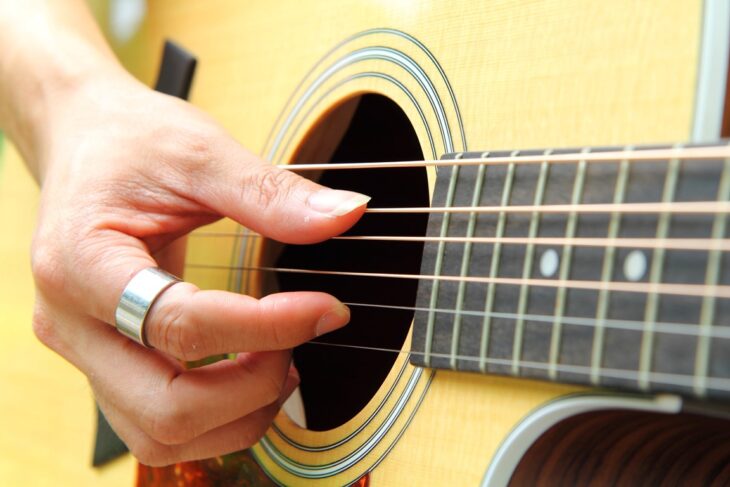
Honestly, one of the most valuable and important picking techniques every guitarist needs to master is fingerpicking. You never know when you’ll find yourself needing to play a six-string without a pick handy. Having a solid finger-picking technique is also a great way to keep the show alive should you drop your pick during a live show or rehearsal.
The finger-picking technique can be split into two main parts: the fingers and the thumb. The thumb rests on the low E string and is responsible for plucking your bass notes, while the fingers are for hitting the higher strings.
In terms of actual technique, you want your fingers to do a kind of “walking” motion like bass players do. Proper classical guitar technique aims to alternate between the index and middle finger but if you are not used to using your fingers at all get comfortable on one before adding the other.
Tapping
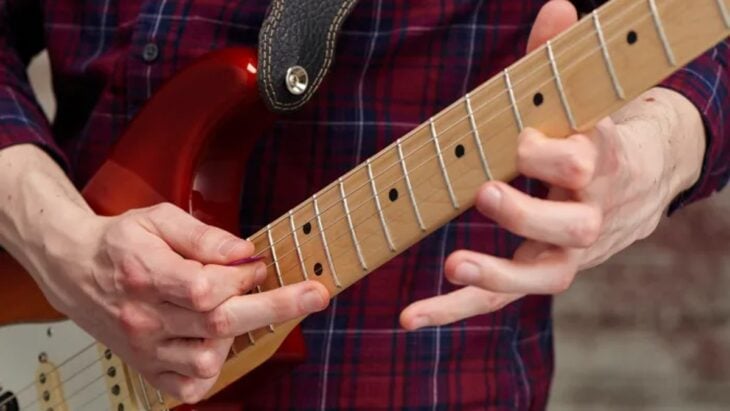
Another super valuable guitar-picking technique you should master is tapping! The older and cooler brother of hammer-ons, tapping is a technique that not only looks amazing but is a solo essential if you’re looking to elevate your sound.
Now, tapping is definitely not a beginner-friendly technique, so I’d recommend having a decent level of confidence with the guitar before giving it a try. Tapping essentially involves you using the tips of your fingers from your picking hand to hammer on and pull off your strings just like you would with your fretting hand.
Keep in mind that this technique is most commonly used on guitars with high gain or distortion, so don’t be disheartened if your acoustic guitar isn’t tapping like Van Halens.

